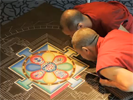It took six days for a group of Buddhist monks to create an extravagant sand mandala at Emory University in Atlanta, Georgia.
But you can watch the entire process in about two minutes thanks to the time-lapse video above.
The sacred art was created March 22-27 as part of Emory’s annual “Tibet Week” celebration. The monks were from Drepung Loseling Monastery Inc., a nonprofit organization in Atlanta dedicated to the study and preservation of Tibetan Buddhist traditions.
Sand mandalas have been in practice for thousands of years, according to Tsepak Rigzin, assistant program director for Drepung Loseling and an adjunct Tibetan language instructor at Emory. Monks use a grated metal rod and a traditional metal funnel called a chak-pur to carefully place millions of grains of colored sand on a table.
“It has to be very exact and very precise,” Rigzin said.
There are hundreds of colorful mandala designs to choose from, Rigzin said, but they all share a basic format of geometric shapes and spiritual symbols.
“Normally the monks who do this, they have to go through a lot of training programs and they have to be authenticated by their masters,” Rigzin said. “They have to memorize the oral texts and learn the ritual.”
The ritual starts with the monks blessing the site of the soon-to-be mandala. They then take several hours to draw an outline of the particular mandala they are about to build – in Emory’s case, the mandala of Avalokiteshvara, or the Buddha of compassion.
Once the outline is in place, the tedious work of laying the sand begins.
“I was really awestruck by their level of concentration,” said Mark Hill, the CNN photographer who captured the time-lapse footage at Emory’s Michael C. Carlos Museum.
“People were in there talking and walking around them, taking pictures. There was a lot going on in the room. But those monks who were building that mandala were absolutely laser-focused on what they were doing.”
Hill set up two cameras in the room. One was an overhead camera that didn’t move during the six days; the other was moved every morning to get a different angle. Both ran continuously, shooting one frame every 30 seconds.
When the last grain of sand was set, the monks didn’t spend time admiring their handiwork. Within about an hour, the elaborate art they had spent days crafting was carefully swept away during a ritualistic ceremony. This is normal practice, Rigzin said; it is done to symbolize the impermanence of life.
The monks passed out half of the sand to the audience as blessings for health and healing. The rest was poured into a nearby river, Rigzin said, as a gift to Mother Earth.
Emory will be having another “Tibet Week” of sorts when the Dalai Lama visits the campus October 17-19. The exiled leader of Tibetan Buddhists has visited the school several times in the past two decades, and he was the commencement speaker there in 1998.
That year, His Holiness also helped form the Emory-Tibet Partnership, which includes various exchange programs between Emory and Tibetan institutions of higher learning.
– Source : religion.blogs.cnn.com

